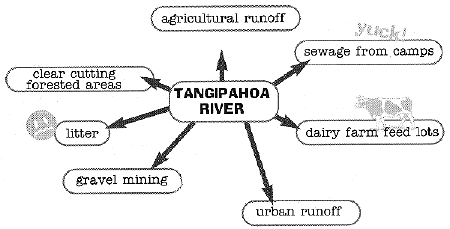
| Materials: |
- copies of Reporting Story Grid
- copies of Issues About Rivers concept map.
| Process: |
- Place students into cooperative groups.
- Using the accompanying concept map Issues About Rivers, have the class brainstorm the issues concerning the Tangipahoa and several of the other rivers in the Basin. If you find additional areas of concern or issues add those to the original concept map or design one in the group. Make a concept map for each river represented by your group.
- Using the articles and additional information gathered by students in the first activity, Rivers of the Basin, have each group focus on a particular river of interest.
- Using the Story Grid examine several of the newspaper articles brought into the cooperative group. When reading or writing a newspaper article look for the Who, What, When, Where, Why, and How shown in the format of the Story Grid. Fill in the accompanying Reporting Story Grid for several of the articles discussed.
Sample (blank):
| Who | What | When | Where | Why | How |
|---|---|---|---|---|---|
Sample:
| Who | What | When | Where | Why | How |
|---|---|---|---|---|---|
| Citizens for a clean Tangipahoa | clean up litter and dumping sites | during Fall Beach Sewwp | along a five mile stretch of the Tangipahoa River | misssion of the organization | asked interested school children to participate |
- Choose an issue as a focus of a newspaper article the group will write on a river in the Lake Pontchartrain Basin.
- Option A:
- Research an issue concerning a river in the Basin, use resources listed in Rivers of the Basin Activity.
- Option B:
- Using the past experiences of students in the cooperative group, interview and write an article about their connection to issues about rivers in the Basin. For example, write an article about lack of septic systems on the Tchefuncte River where a student and her family have a weekend camp or a students' favorite fishing spot in Bayou Lacombe that is littered by boaters' garbage.
- When writing a newspaper-type article be sure to put the most important or most interesting information first. Articles may have any of the components (who, what, when, where, why, or how) first.
- Complete your article by writing a headline. Headlines are often "attention getting" or sensational. Many times headlines are not written by the author of the article. In your cooperative group generate an appropriate headline.
- Include graphics, photos or illustrations to make the article appeal to your audience. Cartoons can be an effective communication tool also.
- After completion of the newspaper article each cooperative group will put articles about rivers together in a class newspaper. Use legal size paper, cutting and pasting articles to fit. Be sure that you check spelling, grammer and punctuation.
- Copy the newspaper for other classes or school groups.